巴西南部新发现的地懒(Xenarthra, Folivora, Mylodontidae)颅骨残骸
IF 0.6
4区 地球科学
Q4 PALEONTOLOGY
引用次数: 0
摘要
髓齿科的诊断通常基于头骨、下颌和牙齿特征,很少基于颅后形态学,因为缺乏与颅后材料相关的颅后材料。颅后解剖学的研究通常以生物力学为重点,反映了骨骼结构的一系列功能,但它们在系统发育分析中的解释仍然有限。在巴西南格兰德州里约热内卢更新世沉积层中,采集了一套重要的颅后标本,属于齿齿科。通过形态学和形态计量学的分析,我们可以观察到一些诊断特征,如肱骨髁内孔和嵴、桡骨轴的形状、胫骨远端关节角以及黄芪近端关节角。该材料还与其他南美地区的标本进行了比较。大部分遗骸归属于粗壮舌龙和长齿龙。此外,在南大州里约热内卢还发现了一种新的Scelidotheriinae。该研究表明颅后形态学有显著差异,从而可以识别一些特定的诊断特征。关键词:Mylodontinae, Scelidotheriinae,后肢,前肢,更新世,里约热内卢Grande do Sul本文章由计算机程序翻译,如有差异,请以英文原文为准。
New postcranial remains of ground sloths (Xenarthra, Folivora, Mylodontidae) from Southern Brazil
Diagnoses of Mylodontidae species are generally based on skull, mandibular, and tooth characteristics, and rarely on postcranial morphology, due to the lack of postcranial material associated with the cranial material. The studies of postcranial anatomy have generally a biomechanical focus and reflect a set of functions of skeletal structures, but their interpretation in phylogenetic analysis is still limited. In Pleistocene deposits of Rio Grande do Sul State, Brazil, an important set of postcranial specimens was collected, belonging to Mylodontidae. They were morphologically and morphometrically analyzed, allowing us to observe some diagnostic characters such as the humeral entepicondylar foramen and crests, shape of the radial shaft, angle of distal articulation of the tibia, as well as the angle of proximal articulation of the astragalus. The material was also compared with specimens from other South American localities. Most of the remains were assigned to Glossotherium robustum and Lestodon armatus. In addition, a new Scelidotheriinae was recorded for Rio Grande do Sul State. The study indicated significant differences in the postcranial morphology, which allowed the recognition of some specific diagnostic characters. Keywords: Mylodontinae, Scelidotheriinae, hindlimb, forelimb, Pleistocene, Rio Grande do Sul.
求助全文
通过发布文献求助,成功后即可免费获取论文全文。
去求助
来源期刊

Revista Brasileira De Paleontologia
PALEONTOLOGY-
CiteScore
1.60
自引率
14.30%
发文量
25
审稿时长
>12 weeks
期刊介绍:
It publishes original contributions on all aspects of Paleontology. Papers are written in English, Spanish, or Portuguese and are reviewed by international experts.
 求助内容:
求助内容: 应助结果提醒方式:
应助结果提醒方式:


